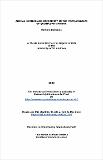Files in this item
Animal similes and creativity in the 'Posthomerica' of Quintus of Smyrna
Item metadata
| dc.contributor.advisor | Campbell, Malcolm | |
| dc.contributor.author | Spinoula, Barbara | |
| dc.coverage.spatial | 266 | en_US |
| dc.date.accessioned | 2012-06-14T14:16:28Z | |
| dc.date.available | 2012-06-14T14:16:28Z | |
| dc.date.issued | 2008 | |
| dc.identifier | uk.bl.ethos.488852 | |
| dc.identifier.uri | https://hdl.handle.net/10023/2780 | |
| dc.description.abstract | This thesis examines the similes of wild animals in the third century epic poem Posthomerica, of Quintus of Smyrna. The similes are studied in both inter-textual and textual levels. The former approach discusses the debt of Quintus' similes to preceding poets in terms of language and imagery. Quintus proves to be a creative and imaginative poet who knows well the tradition he has inherited. The latter approach deals with the similes in the Posthomerica only and reveals how they are thoughtfully inter-related and form sequences which ensure the unity and coherence of the poem, and enhance its overall melancholy tonality. It is also shown that by describing individual cases of doom, the sequences of animal-similes mirror the main theme of the poem, the fall of Troy. Nevertheless Quintus does not concentrate exclusively on the individual victorious hero but gives an important position to the victim, to the mass, as well as to characters who are distant from the battlefield, as women are. This multi-sided presentation of the human being who is directly or indirectly involved in the destructive war brings Quintus close to the Hellenistic attitude of the heroic as well as to psychological portraits of women from that period. The similes in the first chapter describe exclusively male characters and show the heroic valour being undermined. Women have an increasing presence in the similes of the second chapter; vulnerable as they are, they add to the melancholy of the Posthomerica. The third chapter studies the pure wild animal, the beast. The chapter contains an analysis of the beast in epic similes preceding those of Quintus and shows that the beast- simile is mainly psychological and reflects the incomprehensible power of Nature. | en_US |
| dc.language.iso | en | en_US |
| dc.rights | Creative Commons Attribution-NonCommercial-NoDerivs 3.0 Unported | |
| dc.rights.uri | http://creativecommons.org/licenses/by-nc-nd/3.0/ | |
| dc.subject.lcc | PA4407.Q5Z5S7G08 | en_US |
| dc.subject.lcsh | Quintus, Smyrnaeus | en_US |
| dc.subject.lcsh | Quintus, Smyrnaeus, 4th cent. Posthomerica | en_US |
| dc.title | Animal similes and creativity in the 'Posthomerica' of Quintus of Smyrna | en_US |
| dc.type | Thesis | en_US |
| dc.type.qualificationlevel | Doctoral | en_US |
| dc.type.qualificationname | PhD Doctor of Philosophy | en_US |
| dc.publisher.institution | The University of St Andrews | en_US |
This item appears in the following Collection(s)
Except where otherwise noted within the work, this item's licence for re-use is described as Creative Commons Attribution-NonCommercial-NoDerivs 3.0 Unported
Items in the St Andrews Research Repository are protected by copyright, with all rights reserved, unless otherwise indicated.


